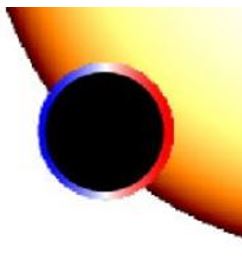An exoplanet with 5400 mph winds – which is seven times the speed of sound, or twenty times faster than anything ever recorded on Earth – has been discovered by scientists at the University of Warwick in England.
Study leader, Tom Louden, who works at the University of Warwick’s Astrophysics Group, said it is the first time a weather system has been directly mapped and measured on an exoplanet. An exoplanet is a planet outside our Solar System that orbits a star.
Commenting on the discovery and over 2km per second winds, Mr. Louden, a PhD student, said:
“This is the first ever weather map from outside of our solar system. Whilst we have previously known of wind on exoplanets, we have never before been able to directly measure and map a weather system.”
 As HD 189733b passes in front of its star and blocks its light, scientists can work out some features of its climate and wind speeds. (Image: University of Warwick)
As HD 189733b passes in front of its star and blocks its light, scientists can work out some features of its climate and wind speeds. (Image: University of Warwick)
Warwick scientists measured the wind speeds on two sides of the exoplanet – called HD 189733b. They detected an incredibly powerful wind, travelling at more than 5400 mph, blowing from its day side to its night side.
Mr. Louden explained:
“HD 189733b’s velocity was measured using high resolution spectroscopy of the Sodium absorption featured in its atmosphere. As parts of HD 189733b’s atmosphere move towards or away from the Earth the Doppler effect changes the wavelength of this feature, which allows the velocity to be measured.”
How was wind speed measured?
The star’s surface is brighter at the centre compared to its edges. As the planet moves in front of it, the relative amount of light blocked by different parts of its atmosphere alters.
For the first time, scientists used this data to measure the velocities on opposite sides of the exoplanet independently, which gave them their velocity map.
The techniques they used in this study could help researchers studying Earth-like planets.
Co-researcher, Dr. Peter Wheatley (Mr. Louden’s supervisor), said:
“We are tremendously excited to have found a way to map weather systems on distant planets. As we develop the technique further we will be able to study wind flows in increasing detail and make weather maps of smaller planets.”
“Ultimately this technique will allow us to image the weather systems on Earth-like planets.”
‘Hot Jupiters’
‘Hot Jupiters’ are among the most studied class of planets. HD 189733b is a Hot Jupiter. It is more than 10% larger than Jupiter, but 180 times closer to its star than Jupiter is to the Sun. It has a temperature of 1200 °C.
This exoplanet’s size and relative proximity to our own Solar System makes it a popular target for astronomers and astrophysicists.
Previous studies have shown that the day side of HD 189733b is a bright shade of blue (to the human eye), which is likely due to clouds of silicate particles floating high in its atmosphere.
The scientists gathered and analyzed data from HARPS (the High Accuracy Radial Velocity Planet Searcher), a high-precision echelle spectrograph installed in 2002 on ESO’s 3.6m telescope at La Silla Observatory, Chile.
Citation: “Spatially resolved eastward winds and rotation of HD189733b,” Tom Louden and Peter J. Wheatley. Cornell University Library. Submitted on 11 Nov, 2015. arXiv:1511.03689 [astro-ph.EP].

